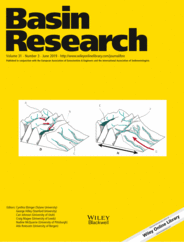
Full text loading...
 , Gavin M. Elliott1, Elisabeth Royce‐Rogers1, Robert L. Gawthorpe2
, Gavin M. Elliott1, Elisabeth Royce‐Rogers1, Robert L. Gawthorpe2 , Tor E. Aas3
, Tor E. Aas3
“Salt” giants are typically halite‐dominated, although they invariably contain other evaporite (e.g. anhydrite, bittern salts) and non‐evaporite (e.g. carbonate, clastic) rocks. Rheological differences between these rocks mean they impact or respond to rift‐related, upper crustal deformation in different ways. Our understanding of basin‐scale lithology variations in ancient salt giants, what controls this and how this impacts later rift‐related deformation, is poor, principally due to a lack of subsurface datasets of sufficiently regional extent. Here we use 2D seismic reflection and borehole data from offshore Norway to map compositional variations within the Zechstein Supergroup (ZSG) (Lopingian), relating this to the structural styles developed during Middle Jurassic‐to‐Early Cretaceous rifting. Based on the proportion of halite, we identify and map four intrasalt depositional zones (sensu Clark et al., Journal of the Geological Society, 1998, 155, 663) offshore Norway. We show that, at the basin margins, the ZSG is carbonate‐dominated, whereas towards the basin centre, it becomes increasingly halite‐dominated, a trend observed in the UK sector of the North Sea Basin and in other ancient salt giants. However, we also document abrupt, large magnitude compositional and thickness variations adjacent to large, intra‐basin normal faults; for example, thin, carbonate‐dominated successions occur on fault‐bounded footwall highs, whereas thick, halite‐dominated successions occur only a few kilometres away in adjacent depocentres. It is presently unclear if this variability reflects variations in syn‐depositional relief related to flooding of an underfilled presalt (Early Permian) rift or syn‐depositional (Lopingian) rift‐related faulting. Irrespective of the underlying controls, variations in salt composition and thickness influenced the Middle Jurassic‐to‐Early Cretaceous rift structural style, with diapirism characterising hangingwall basins where autochthonous salt was thick and halite‐rich and salt‐detached normal faulting occurring on the basin margins and on intra‐basin structural highs where the salt was too thin and/or halite‐poor to undergo diapirism. This variability is currently not captured by existing tectono‐stratigraphic models largely based on observations from salt‐free rifts and, we argue, mapping of suprasalt structural styles may provide insights into salt composition and thickness in areas where boreholes are lacking or seismic imaging is poor.

Article metrics loading...

Full text loading...
References


Data & Media loading...

